There are some „truths“ in reenactment which are rarely questioned, although maybe they should be. These are sometimes called „reenactorisms“, self-propagating myths that are perpetuated by the „monkey see, monkey do“ attitude that befalls reenactors, be they inexperienced or veterans.

A reenactor’s knot (image copyright The Jelling Dragon)
One of those truths is a trivially sounding question: How long were viking-age belts? We have come to accept that they had a buckle and a strap-end, and the strap-end hung about crotch to mid-thigh – 20 to 40 cm from the buckle. The strap was fed through the buckle and then knotted just behind it, hanging straight down. This is sometimes called „the reenactor’s knot“, and there doesn’t seem to be an awful lot of evidence for it. Apart from that, it is really impractical because you constantly have a strap-end dangling between your legs. 😉
So, an excellent reenactor and designer of bronze jewelry replicas, Burr Öhrström, took it upon himself to research the Birka graves for evidence of belts and buckles. I did the same tonight (oblivious of the fact that he already had done that) and would like to systematize the conclusions a little.
Methodology
First, I’ll show the sheer facts – graves with relevant grave goods, and the relative distances between the strap-ends and buckles. I have decided to keep this post purely about the graves, and not start analyzing iconography, statues or other works.
The analysis will then try to show what was most likely the prevalent fashion of belt, and how likely this analysis is accurate. So, without further ado, let’s dive into the data.
Graves with belt and strap-ends in Birka
There aren’t a terrible lot of belt accessoire finds in Birka’s graves. I did not research the Black Earth in this posting because it wouldn’t be very helpful – this article is based largely on in-situ grave drawings and those are naturally unavailable in the settlement finds.
The belt finds from Birka’s graves are shown in Birka I: Die Tafeln, plates 86 and 87. The oriental and horse-belts are on plates 88-90.
Please see the below table for a list of belt accessoire finds in Birka. The order is not random – it follows the order in Birka I:Plates. OK, it is random.
| Grave number | Grave type | Belt buckle | Strap-end | Comment |
|---|---|---|---|---|
| 750 | Inhumation | ✔ | ✔ | Carolingian rectangular strap-end; silver |
| 750 | Inhumation | ✔ | ✔ | Borre-style decoration; silver |
| 761 | Inhumation | ✔ | ✔ | – |
| 1003 B | Cremation | ✔ | ✔ | Second layer of a double cremation grave |
| 618 | Inhumation | ✔ | Inhumation and cremation grave; strap-end in the inhumation part | |
| 1059 | Cremation | ✔ | Thin and long strap-end with animal head, parallel finds in Hedeby | |
| 456 | Cremation | ✔ | ||
| 735 | Inhumation | ✔ | Double grave | |
| 29 | Cremation | ✔ | ||
| 506 | Inhumation | ✔ | ||
| 773 B | Cremation | ✔ | ||
| 157 | Inhumation | ✔ | ||
| 373 | Cremation | ✔ | ||
| 407 | Cremation | ✔ (2) | ||
| 158 | Inhumation | copper-alloy belt loop/slider in the inhumation part of an inhumation/cremation grave | ||
| 1076 | Inhumation | ✔ | ✔ | |
| 1030 | Inhumation | ✔ | ✔ | |
| 917 | Cremation | ✔ | ✔ | |
| 488 | Inhumation | ✔ | ✔ | |
| 949 | Inhumation | ✔ | ✔ | |
| 71 | Cremation | ✔ | ||
| 229 | Cremation | ✔ | ||
| 956 | Inhumation | ✔ | ||
| 478 | Inhumation | ✔ | ✔ | Buckle not shown in Birka I |
| 918 | Inhumation | ✔ | ✔ | Fragments of the buckle corroded to strap-end |
| 913 | Cremation | ✔ | ✔ | Eastern belt |
| 369 | Cremation | ✔ | ✔ | Horse gear |
| 716 | Inhumation | ✔ | ✔ | Eastern belt |
| 1074 | Inhumation | ✔ | ✔ | Eastern belt |
Irrelevant graves
Of all the graves in this table, we will have to exclude the following:
- Cremation graves, as it is impossible to determine the relative position of the belt buckle and strap-end to each other.
- Inhumation graves with only buckle or strap-end, not both – again, it’s impossible to deduce the relative positions.
- Graves with Eastern belts, as these were most likely made in another fashion (see my earlier work on the belt from Bj716 [DE])
- Horse gear
Relevant graves
This reduces our table quite a lot. See below the table of all graves with relevant graves.
| Grave number | Grave type | Belt buckle | Strap-end | Comment |
|---|---|---|---|---|
| 750 | Inhumation | ✔ | ✔ | Carolingian rectangular strap-end; silver |
| 750 | Inhumation | ✔ | ✔ | Borre-style decoration; silver |
| 761 | Inhumation | ✔ | ✔ | – |
| 1076 | Inhumation | ✔ | ✔ | |
| 1030 | Inhumation | ✔ | ✔ | |
| 488 | Inhumation | ✔ | ✔ | |
| 949 | Inhumation | ✔ | ✔ | |
| 478 | Inhumation | ✔ | ✔ | Buckle not shown in Birka I |
| 918 | Inhumation | ✔ | ✔ | Fragments of the buckle corroded to strap-end |
The grave plans
I took most of these plans from Birka I, which is thankfully freely available as a high-resolution PDF. In two cases, I had to resort to Stolpe’s original pencil drawings as the printed plan was either unclear or unavailable.
Grave 478
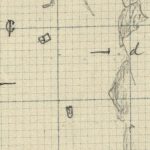 The grave plan (this is Stolpe’s original sketch) shows that the belt buckle (the item in the center-left square, topright corner) and the strap-end (lower right square) are easily 25cm apart.
The grave plan (this is Stolpe’s original sketch) shows that the belt buckle (the item in the center-left square, topright corner) and the strap-end (lower right square) are easily 25cm apart.
Grave 488
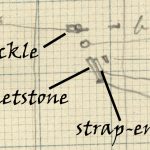 Here, the strap-end (or at least what I think is the strap-end) and the buckle are about 10cm apart, but there’s no scale to the drawing (which is, again, Stolpe’s original sketch).
Here, the strap-end (or at least what I think is the strap-end) and the buckle are about 10cm apart, but there’s no scale to the drawing (which is, again, Stolpe’s original sketch).
Grave 750
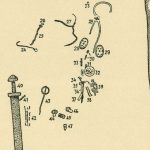
This grave is interesting. It’s a double grave, and both belt sets are very close to each other. The carolinigian set is numbered 44 and 45, the Borre set is 46 and 47. This could have meant that the corpses were placed one upon another – maybe the woman was sat on her husband’s lap. It’s also one of the very, very few places where there are strong indicators for a woman’s belt set. Both belt sets are silver and cannot possibly have belonged to one belt with two straps (they are stylistically completely different).
The first set of strap-end and buckle, the carolingian one with the rectangular strap-end, are very close to each other, only about 5cm apart. The second set, the Borre decorated one, is futher apart – maybe 10cm.
Grave 761
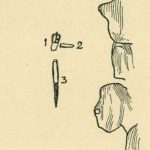 Belt and strap-end are directly adjacent to each other.
Belt and strap-end are directly adjacent to each other.
Grave 918
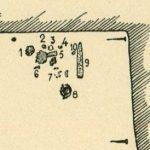 For this grave, the illustration is note very helpful, the strap-end is number 5 on the drawing. However, the text in Birka I states that „irrelevant remains of the buckle are corroded to a piece of fabric and the strap-end“. This means that strap-end and buckle were directly adjacent to each other.
For this grave, the illustration is note very helpful, the strap-end is number 5 on the drawing. However, the text in Birka I states that „irrelevant remains of the buckle are corroded to a piece of fabric and the strap-end“. This means that strap-end and buckle were directly adjacent to each other.
Grave 949
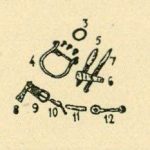 A rather clear-cut case: belt buckle (9) and strap-end (8) are almost on top of each other. What looks like another strap-end, number (6), is actually a whetstone.
A rather clear-cut case: belt buckle (9) and strap-end (8) are almost on top of each other. What looks like another strap-end, number (6), is actually a whetstone.
Grave 1030
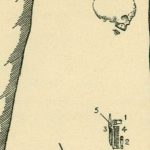 About 8cm distance between buckle and strap-end.
About 8cm distance between buckle and strap-end.
Grave 1076
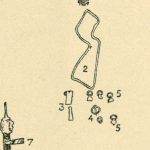 Buckle and strap-end are directly adjacent to each other, maybe 5cm distance (assuming that the strap-end was flipped over during composition, and measured from its lower end).
Buckle and strap-end are directly adjacent to each other, maybe 5cm distance (assuming that the strap-end was flipped over during composition, and measured from its lower end).
Analysis
Analyzing the information above comes with several caveats. The position of items in inhumation graves can vary substantially from the placement at the time of the burial. This is due to the decomposition process of the body (which includes gases, flattening of the soft tissue, and induces considerable movement), but also geological phenomena, grave disturbance by robbers, animals or new burials (re-usage of grave space was not uncommon in Birka). This means that the following analysis should be taken with a huge grain of salt.
From the 9 relevant graves (I’ll count Bj750 as two graves), the relative positions of strap-end and belt buckle were as follows:
| Grave number | Distance |
|---|---|
| 478 | 25cm |
| 488 | 10cm |
| 750 (carolingian) | 5cm |
| 750 (Borre) | 10cm |
| 761 | 2cm |
| 918 | 0cm (on top of each other) |
| 949 | 3cm |
| 1030 | 8cm |
| 1076 | 5cm |
Looking at the numbers, there is only one clear case for a „long, dangling belt“, and that’s grave 478. The others have distances that are more in line with modern belt fashion – 10cm seems to be a maximum of the belt end’s length.
However, it’s (at least for me, as a layman) hard to analyze how much of this data is based on movement, but I’ll try to theorize a little. Please bear with me, it’s going to be a little macabre.
Decomposition theory
If a body is placed in a coffin grave (which was the prevalent measure of inhumation in the graves we are looking at right now), I think the following will happen. The coffin creates an empty, air-filled space between the corpse and the soil, which facilitates decomposition. When decomposition sets in, the body will first become bloated due to the corpse gases. A belt will bear the brunt of this bloating (if it was properly closed during burial), and either be torn open or stay closed through this phase of decomposition. If we imagine a belt with a long strap-end, where would that strap-end be placed during burial? Either on the thighs or on the hip, parallel or on top of the belt, just much left to it (near the hip bones). If the body gets bloated, I cannot imagine a way that would shift the belt buckle and strap ends towards each other. I assume that they would rather shift away from each other (the strap-end would slide off the now bloated belly while the buckle would be held in place).
After the body and the garments are decomposed into a skeleton, eventually the (also decomposing) wooden coffin would break down and soil would cover the remains. During that phase, and during animal burrowing, the strapend and buckle could hardly be pushed closer together, as they are on the same horizontal plane already.
This is purely speculation though, I am not a pathologist.
Long or short belts?
If we stick to the pure facts, i.e. the grave illustrations, there can, in my opinion, only be one result: Belts in Birka were not work with long, dangling strap-ends knotted in the „reenactor’s knot“, but very similar to how we wear belts today. They would allow for some gaining or losing weight, thick or thin garments, but not have a reserve of 30-40cm between the buckle and the strap-end.
Therefore, I think that the reenactor’s fashion of having a strap-end dangling down the leg is, at least for Birka, not based on the facts that we have, as scarce as they may be.

Pingback: Délka raně středověkých opasků | Projekt Forlǫg
Pingback: The Length of Early Medieval Belts | Projekt Forlǫg
Pingback: La longueur des ceintures en reconstitution – Projekt Forlǫg
Pingback: La longitud de los cinturones altomedievales – Projekt Forlǫg
Pingback: Kit Improvements- making a new Viking Belt – In The Shield Wall